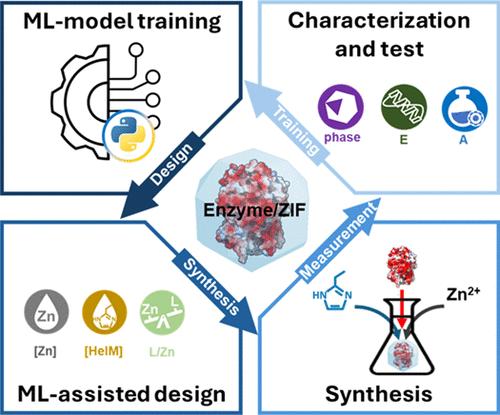Machine Learning Optimizing Enzyme/ZIF Biocomposites for Enhanced Encapsulation Efficiency and Bioactivity
引用次数: 0
Abstract
In this study, we present the first example of using a machine learning (ML)-assisted design strategy to optimize the synthesis formulation of enzyme/ZIFs (zeolitic imidazolate framework) for enhanced performance. Glucose oxidase (GOx) and horseradish peroxidase (HRP) were chosen as model enzymes, while Zn(eIM)2 (eIM = 2-ethylimidazolate) was selected as the model ZIF to test our ML-assisted workflow paradigm. Through an iterative ML-driven training-design-synthesis-measurement workflow, we efficiently discovered GOx/ZIF (G151) and HRP/ZIF (H150) with their overall performance index (OPI) values (OPI represents the product of encapsulation efficiency (E in %), retained enzymatic activity (A in %), and thermal stability (T in %)) at least 1.3 times higher than those in systematic seed data studies. Furthermore, advanced statistical methods derived from the trained random forest model qualitatively and quantitatively reveal the relationship among synthesis, structure, and performance in the enzyme/ZIF system, offering valuable guidance for future studies on enzyme/ZIFs. Overall, our proposed ML-assisted design strategy holds promise for accelerating the development of enzyme/ZIFs and other enzyme immobilization systems for biocatalysis applications and beyond, including drug delivery and sensing, among others.

机器学习优化酶/ZIF 生物复合材料,提高封装效率和生物活性
在本研究中,我们首次举例说明了如何利用机器学习(ML)辅助设计策略来优化酶/ZIF(唑基咪唑酸框架)的合成配方,以提高其性能。葡萄糖氧化酶(GOx)和辣根过氧化物酶(HRP)被选为模型酶,而 Zn(eIM)2(eIM = 2-乙基咪唑酸盐)被选为模型 ZIF,以测试我们的 ML 辅助工作流程范例。通过迭代式 ML 驱动的 "训练-设计-合成-测量 "工作流程,我们高效地发现了 GOx/ZIF (G151) 和 HRP/ZIF (H150),其总体性能指数(OPI)值(OPI 表示封装效率(E,单位 %)、保留酶活性(A,单位 %)和热稳定性(T,单位 %)的乘积)至少是系统种子数据研究的 1.3 倍。此外,从训练有素的随机森林模型中得出的先进统计方法定性和定量地揭示了酶/ZIF 系统中合成、结构和性能之间的关系,为今后的酶/ZIF 研究提供了宝贵的指导。总之,我们提出的 ML 辅助设计策略有望加速酶/ZIF 及其他酶固定化系统的开发,使其应用于生物催化及其他领域,包括药物输送和传感等。
本文章由计算机程序翻译,如有差异,请以英文原文为准。
求助全文
约1分钟内获得全文
求助全文

 求助内容:
求助内容: 应助结果提醒方式:
应助结果提醒方式:


